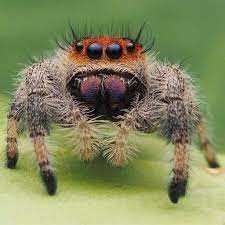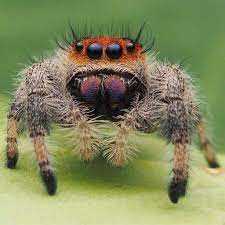
As its name suggests, the Phidippus regius is an excellent jumper, capable of leaping up to 50 times its own body length. This extraordinary jumping ability allows the spider to effortlessly navigate its surroundings and swiftly catch its prey.
The Royal Jumping Spider possesses a unique set of characteristics that distinguish it from other spider species. Its large, forward-facing eyes provide it with excellent vision, enabling it to accurately spot and track its prey. Additionally, the Phidippus regius is known for its fuzzy appearance, which adds to its charm.
This species is a skilled predator, feeding on a variety of insects such as flies, ants, and other small arthropods. They use their strong jaws to inject venom into their prey, immobilizing it before consuming it. Their hunting technique is both swift and precise, making them formidable predators in the arachnid world.
Overview of Phidippus regius
Phidippus regius is native to the southeastern United States and is found in a variety of habitats, including forests, grasslands, and even urban areas. They are commonly found on trees, shrubs, and other vegetation where they use their incredible jumping ability to catch their prey.
One of the most remarkable features of the Royal Jumping Spider is its large, forward-facing eyes. These eyes provide them with excellent vision and depth perception, allowing them to accurately target and pounce on their prey. Their ability to jump distances of up to 50 times their own body length is possible due to the unique muscles and attachment structures in their legs.
Overall, Phidippus regius is an intriguing and captivating species of spider. Its unique characteristics, such as its black and fuzzy appearance, exceptional jumping ability, and impressive vision, make it a fascinating creature to study and observe in nature.
Unique Characteristics of Phidippus regius
- Coloration: The Phidippus regius is known for its stunning black coloration, which gives it a sleek and elegant appearance. This characteristic distinguishes it from other jumping spiders.
- Fuzzy Appearance: One of the most distinctive features of the Phidippus regius is its fuzzy exoskeleton. Its body is covered with fine hairs, adding to its overall charm and making it appear almost velvety to the touch.
- Jumping Ability: As its name suggests, the Royal Jumping Spider is an expert jumper. It possesses exceptional leg strength, allowing it to leap impressive distances and pounce on its prey with great accuracy.
Furthermore, the Phidippus regius possesses large eyes that provide excellent vision and depth perception. It uses this keen eyesight to locate and stalk its prey effectively.
These unique characteristics contribute to the Phidippus regius’ success as a predator. Its specialized adaptations help it navigate its environment and hunt for food efficiently. It is truly a fascinating species to observe and study.
The Royal Jumping Spider’s Habitat and Behavior
The Royal Jumping Spider has a distinctive glossy black body with a vibrant white dorsal stripe. Its eight eyes arranged in two rows, with the front row being larger and more prominent, giving them excellent vision. These spiders are generally small in size, measuring around 1-1.5 centimeters in length.
One of the most striking behaviors of the Royal Jumping Spider is its exceptional jumping ability. They are agile hunters and use their powerful hind legs to pounce on their prey with great precision. Despite being small in size, they are skilled predators and can capture flying insects in mid-air.
These spiders are a common sight in warm and dry habitats, such as grasslands, shrublands, and even urban areas. They can be found on tree trunks, leaves, and other surfaces where they build their nests or waiting stations. The Royal Jumping Spider is known for its ability to camouflage well with its surroundings, making it more difficult for predators to spot them.
Another interesting behavior of the Royal Jumping Spider is its mating ritual. During courtship, the male performs an elaborate and intricate dance to attract the female. This dance involves a series of intricate movements, vibrations, and visual displays. If successful, the male will present a gift of wrapped prey to the female, as a form of courtship gift.
Despite their small size, the Royal Jumping Spider plays an essential role in the ecosystem as a predator, helping to control insect populations. They are often found in gardens and agricultural areas, where they help in controlling pests naturally, reducing the need for chemical pesticides.
Conservation Status and Importance of Phidippus regius
Importance of Phidippus regius
Conservation Status

The Royal Jumping Spider is primarily found in the southeastern region of the United States, where it inhabits a variety of environments including forests, grasslands, and urban areas. Their adaptability and wide distribution contribute to their overall resilience as a species.
However, like many arachnids, Phidippus regius faces potential risks from habitat loss and degradation due to human activities. Deforestation, urbanization, and pesticide use can all negatively impact their populations. It is crucial to raise awareness about the importance of conserving these fascinating creatures and their habitats to ensure their continued existence in the wild.

I’m Lena Adams—a product of an unconventional upbringing in the African wilderness. My father, a daring explorer of African wildlife, sparked my fascination with reptiles, a passion that intertwined with the tragic loss of my mother during an expedition, leaving an indelible mark on my life. Driven to understand the creatures that captivated my parents, I embarked on my journey, sharing insights about reptiles, frogs, and lizards on my website. Through my explorations and conservation efforts, I honour my family’s legacy while seeking connections—to the creatures, nature, and the mother whose presence I yearn to understand.
